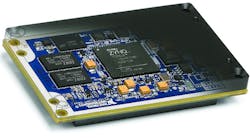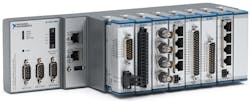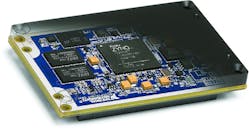National Instruments originally built its CompactRIO around a conventional processor and FPGA (see “Compact RIO Builds on Core i7 and Spartan-6 FPGA” on electronicdesign.com). It provided a modular system with the interconnect and functionality of an FPGA. Also, it proved ideal for process control as well as dealing with test and measurement applications. The complexity of the system was hidden behind the graphical LabVIEW programming environment (see “Latest LabVIEW Version Swings For The ‘Learn To Program’ Fences” on electronicdesign.com). Its virtual instruments mapped nicely to Compact RIO’s pluggable functionality.
NI has updated the platform to take advantage of FPGA advances utilizing Xilinx’s Zynq (see “FPGA Packs in Dual Cortex-A9 Micro” on electronicdesign.com), which incorporates a dual-core ARM Cortex-A9. The cRIO-9068 is based on the Zynq-7000 chip (Fig. 1). It runs Linux and it can be programmed using LabVIEW as well as other programming languages such as C and C++.
Now, the sbRIO-9651 (Fig. 2) combines the best of the company’s Xilinx Zynq-based Compact RIO platform into a system-on-module (SOM). With a 667-MHz Xilinx Zynq 7020 and an Artix-7 FPGA fabric, it uses less than 5 W. It also boasts Gigabit Ethernet and USB 2.0 host and device interfaces. Furthermore, it can handle serial interfaces and CAN. And, it has has 512 Mbytes of DRAM and 512 Mbytes of flash memory.
The sbRIO-9651 lacks the sockets of the CompactRIO system, but the SOM is designed for applications developed using CompactRIO to be turned into production embedded systems with the SOM at its heart. The SOM runs Linux and can handle a wide range of applications.


